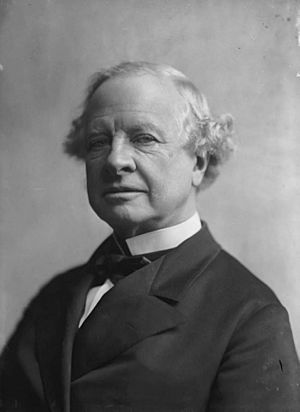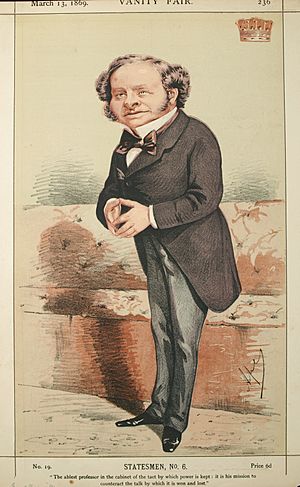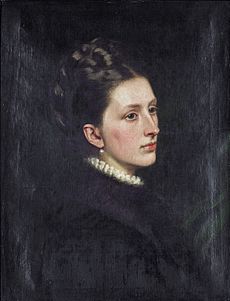Granville Leveson-Gower, 2nd Earl Granville facts for kids
Quick facts for kids
The Earl Granville
|
|
|---|---|

The 2nd Earl Granville, by Alexander Bassano, c. 1885-90
|
|
| Leader of the House of Lords | |
| In office 8 February 1855 – 21 February 1858 |
|
| Monarch | Queen Victoria |
| Prime Minister | The Viscount Palmerston |
| Preceded by | The Earl of Aberdeen |
| Succeeded by | The Earl of Derby |
| In office 18 June 1859 – 29 October 1865 |
|
| Monarch | Queen Victoria |
| Prime Minister | The Viscount Palmerston |
| Preceded by | The Earl of Derby |
| Succeeded by | The Earl of Derby |
| In office 9 December 1868 – 17 February 1874 |
|
| Monarch | Queen Victoria |
| Prime Minister | William Ewart Gladstone |
| Preceded by | The Earl of Malmesbury |
| Succeeded by | The Duke of Richmond |
| In office 28 April 1880 – 9 June 1885 |
|
| Monarch | Queen Victoria |
| Prime Minister | William Ewart Gladstone |
| Preceded by | The Earl of Beaconsfield |
| Succeeded by | The Marquess of Salisbury |
| In office 6 February 1886 – 20 July 1886 |
|
| Monarch | Queen Victoria |
| Prime Minister | William Ewart Gladstone |
| Preceded by | The Marquess of Salisbury |
| Succeeded by | The Marquess of Salisbury |
| Secretary of State for Foreign Affairs | |
| In office 26 December 1851 – 27 February 1852 |
|
| Monarch | Queen Victoria |
| Prime Minister | Lord John Russell |
| Preceded by | The Viscount Palmerston |
| Succeeded by | The Earl of Malmesbury |
| In office 6 July 1870 – 21 February 1874 |
|
| Monarch | Queen Victoria |
| Prime Minister | William Ewart Gladstone |
| Preceded by | The Earl of Clarendon |
| Succeeded by | The Earl of Derby |
| In office 28 April 1880 – 24 June 1885 |
|
| Monarch | Queen Victoria |
| Prime Minister | William Ewart Gladstone |
| Preceded by | The Marquess of Salisbury |
| Succeeded by | The Marquess of Salisbury |
| Secretary of State for the Colonies | |
| In office 9 December 1868 – 6 July 1870 |
|
| Prime Minister | William Ewart Gladstone |
| Preceded by | The Duke of Buckingham and Chandos |
| Succeeded by | The Earl of Kimberley |
| Lord President of the Council | |
| In office 28 December 1852 – 12 June 1854 |
|
| Monarch | Queen Victoria |
| Prime Minister | The Earl of Aberdeen |
| Preceded by | The Earl of Lonsdale |
| Succeeded by | Lord John Russell |
| In office 8 February 1855 – 26 February 1858 |
|
| Monarch | Queen Victoria |
| Prime Minister | The Viscount Palmerston |
| Preceded by | Lord John Russell |
| Succeeded by | The Marquess of Salisbury |
| In office 18 June 1859 – 6 July 1866 |
|
| Monarch | Queen Victoria |
| Prime Minister | The Viscount Palmerston The Earl Russell |
| Preceded by | The Marquess of Salisbury |
| Succeeded by | The Duke of Buckingham and Chandos |
| Chancellor of the Duchy of Lancaster | |
| In office 21 June 1854 – 30 January 1855 |
|
| Monarch | Queen Victoria |
| Prime Minister | The Earl of Aberdeen |
| Preceded by | Edward Strutt |
| Succeeded by | The Earl of Harrowby |
| Additional positions | |
| Personal details | |
| Born | 11 May 1815 London |
| Died | 31 March 1891 (aged 75) London |
| Political party | Liberal |
| Spouses | (1) Mary Louise von Dalberg (1813–1860) (2) Castila Rosalind Campbell (died 1938) |
| Children | Granville Leveson-Gower, 3rd Earl Granville William Leveson-Gower, 4th Earl Granville |
| Parents | Granville Leveson-Gower, 1st Earl Granville Lady Harriet Cavendish |
| Alma mater | Christ Church, Oxford |
Granville George Leveson-Gower, 2nd Earl Granville (born May 11, 1815 – died March 31, 1891) was an important British politician and diplomat. He was a member of the Liberal Party. Before he became an Earl in 1846, people called him Lord Leveson.
He is most famous for his time as the Foreign Secretary. This job meant he was in charge of Britain's relationships with other countries. He worked hard to keep Britain out of European wars. He also helped improve relations with the United States after some difficult times during the American Civil War.
Contents
Early Life and Education
Granville Leveson-Gower was born in London. His father was Granville Leveson-Gower, the 1st Earl Granville. His mother was Lady Harriet Cavendish. He came from a very important family with many connections.
He went to Eton, a famous school, and then studied at Christ Church, Oxford, a well-known university.
Starting a Political Career
After finishing his studies, Granville worked for a short time in Paris with his father. In 1836, he was elected to Parliament as a Whig Member of Parliament (MP) for Morpeth. An MP is someone elected to represent people in the government.
From 1840 to 1841, he worked as the Under-Secretary of State for Foreign Affairs. This meant he helped the main Foreign Secretary. When his father passed away in 1846, Granville became the 2nd Earl Granville and joined the House of Lords. This is the upper house of the British Parliament.
Key Government Roles
In the House of Lords, he became known for supporting "Free Trade." This idea meant that countries should trade with each other without many taxes or rules. When Lord John Russell formed a government in 1846, Granville became the Master of the Buckhounds. This was a ceremonial role in the royal household.
- In 1848, he became the Vice-President of the Board of Trade. This role involved helping with business and trade in Britain.
- He played a big part in organizing the Great Exhibition of 1851. This was a huge event that showed off new inventions and art from around the world.
- At the end of 1851, he briefly became the Foreign Secretary.
When Lord Aberdeen formed a new government in 1852, Granville took on more important jobs:
- He became the Lord President of the Council. This person advises the monarch and oversees certain government departments.
- In 1854, he became the Chancellor of the Duchy of Lancaster. This role manages land and income for the monarch.
- Under Prime Minister Lord Palmerston in 1855, he was again the Lord President of the Council.
Granville was very interested in education. He was elected as the Chancellor of the University of London in 1856 and held this position for 35 years. He strongly supported allowing women to attend universities and teaching modern languages.
From 1855, Lord Granville was the leader of the Liberals in the House of Lords. In 1859, Queen Victoria even asked him to try and form a government, but he couldn't. He continued to serve in important roles, including becoming the Lord Warden of the Cinque Ports. This was an old, honorable position for protecting the English coast.
Military Service
Granville also had a military background. He served in the Staffordshire Yeomanry, which was a part-time army unit. He became a Major in 1848 and a Lieutenant-Colonel in 1854. Later, as Lord Warden, he was made an Honorary Colonel of the 1st Cinque Ports Artillery Volunteers.
Business Interests
Lord Granville was also a businessman. He owned coal and iron mines in Stoke-on-Trent. He was the main owner of the Shelton Iron & Steel Co. This company had many blast furnaces and puddling furnaces, which were used to make iron. He also owned shares in another company called the Lilleshall Company.
Foreign Policy and Diplomacy
Lord Granville's most important work was as the Foreign Secretary. He held this job from 1870 to 1874 and again from 1880 to 1885.
Working for Peace
During the American Civil War, Granville believed Britain should not get involved. His advice helped Prime Minister Palmerston decide not to interfere. This helped keep relations between Britain and the United States stable.
In 1868, he became the Colonial Secretary in Gladstone's government. This job involved managing Britain's colonies around the world.
When he became Foreign Secretary again in 1870, Europe was facing possible wars. Granville worked to solve problems peacefully. He helped set up talks to settle disputes with the United States. This led to the Treaty of Washington in 1871. This treaty helped solve many issues between Britain and America.
One example was the San Juan Island Water Boundary Dispute. This was a disagreement over the border between the US and Canada in the Puget Sound. Granville helped arrange for the German Emperor to decide the border in 1872. By using international arbitration (where an independent person or group helps solve a dispute), Granville showed how countries could solve problems without fighting.
Challenges in Foreign Affairs
In 1870, the Franco-Prussian War broke out. This was a big surprise to many. Russia took advantage of the war to break parts of the Treaty of Paris, which had ended the Crimean War. Granville protested, but he couldn't stop Russia.
He also faced challenges with Russia's expansion in Central Asia, an area known as The Great Game. In 1873, Russia took control of the Khanate of Khiva, which was supposed to be a neutral area. Granville had to accept this.
When the Conservative Party came to power in 1874, Granville often criticized their foreign policy. He believed in more peaceful and flexible ways of dealing with other countries. He returned to the Foreign Office in 1880. However, he faced new challenges, especially with Germany's growing power under Bismarck.
Granville made a mistake by not realizing how important the Angra Pequena issue was in Africa. This led to him having to give in to Bismarck's demands. Later, when Gladstone supported Home Rule for Ireland, Granville agreed with him. He retired from public life in 1886.
Family Life
Lord Granville married his first wife, Marie Louise Pelline de Dalberg, in 1840. She was the daughter of a famous diplomat. She passed away in 1860.
He married his second wife, Castilia Rosalind Campbell, on September 26, 1865. They had several children:
- Lady Victoria Alberta Leveson-Gower (1867–1953)
- Lady Sophia Castelia Mary Leveson-Gower (1870–1934)
- Granville Leveson-Gower, 3rd Earl Granville (1872–1939), who became the 3rd Earl
- Lady Susan Katherine Leveson-Gower (1876–1878)
- Vice-Admiral William Spencer Leveson-Gower, 4th Earl Granville (1880–1953), who became the 4th Earl
Death
Granville George Leveson-Gower died in London on March 31, 1891. His eldest son became the 3rd Earl Granville. He was buried in the family tomb in Stone, Staffordshire.
Legacy
Several places were named after him:
- The city of Vancouver in Canada was called Granville from 1870 until 1886. Granville Street is a major road there.
- Granville house at Epsom College was named in his honor.
- Granville is a suburb and train station in Sydney, Australia. It was named in 1880.
- Granville Road, Granville Square, and Granville Circuit in Hong Kong are named after him.
- The Granville Hotel, Ramsgate, in England, was also named after him.
See also





